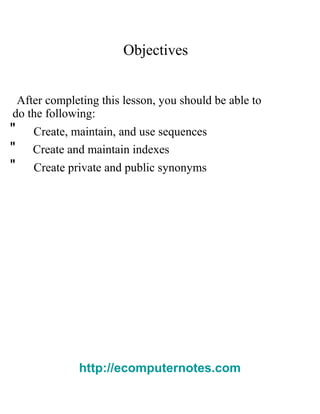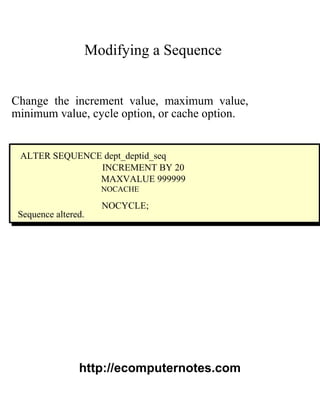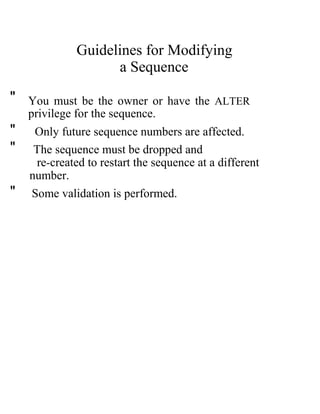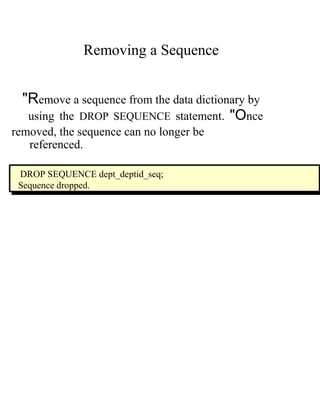e computer notes - Other database objects
- 2. Objectives After completing this lesson, you should be able to do the following: " Create, maintain, and use sequences " Create and maintain indexes " Create private and public synonyms http://ecomputernotes.com
- 3. Database Objects Object Description Basic unit of storage; composed of rowsTable and columns View Logically represents subsets of data from one or more tables Generates primary key valuesSequence Index Improves the performance of some queries Synonym Alternative name for an object http://ecomputernotes.com
- 4. What Is a Sequence? A sequence: " Automatically generates unique numbers " Is a sharable object " Is typically used to create a primary key value " Replaces application code " Speeds up the efficiency of accessing sequence values when cached in memory http://ecomputernotes.com
- 5. The CREATE SEQUENCE Statement Syntax Define a sequence to generate sequential numbers automatically: CREATE SEQUENCE sequence [INCREMENT BY n] [START WITH n] [START WITH n] [{MAXVALUE n | NOMAXVALUE}] [{MINVALUE n | NOMINVALUE}] [{CYCLE | NOCYCLE}] [{CACHE n | NOCACHE}]; http://ecomputernotes.com
- 6. Creating a Sequence " Create a sequence named DEPT_DEPTID_SEQ to be used for the primary key of the DEPARTMENTS table. " Do not use the CYCLE option. CREATE SEQUENCE dept_deptid_seq INCREMENT BY 10 START WITH 120 START WITH 120 MAXVALUE 9999 NOCACHE NOCYCLE; Sequence created. http://ecomputernotes.com
- 7. Confirming Sequences " Verify your sequence values in the USER_SEQUENCES data dictionary table. SELECT sequence_name, min_value, max_value, increment_by, last_number FRO M user_sequences; " The LAST_NUMBER column displays the next available sequence number if NOCACHE is specified. http://ecomputernotes.com
- 8. NEXTVAL and CURRVAL Pseudocolumns " NEXTVAL returns the next available sequence value. It returns a unique value every time it is referenced, even for different users. " CURRVAL obtains the current sequence value. " NEXTVAL must be issued for that sequence before CURRVAL contains a value. http://ecomputernotes.com
- 9. Using a Sequence " Insert a new department named ³Support´ in location ID 2500. INSERT INTO departments(department_id, department_name, location_id) VALUES (dept_deptid_seq.NEXTVAL, 'Support', 2500); 1 row created. " View the current value for the DEPT_DEPTID_SEQ sequence. SELECT dept_deptid_seq.CURRVAL FROM dual; http://ecomputernotes.com
- 10. Using a Sequence "Caching sequence values in memory gives faster access to those values. "Gaps in sequence values can occur when: A rollback occurs The system crashes A sequence is used in another table " If the sequence was created with NOCACHE, view the next available value, by querying the USER_SEQUENCES table. http://ecomputernotes.com
- 11. Modifying a Sequence Change the increment value, maximum value, minimum value, cycle option, or cache option. ALTER SEQUENCE dept_deptid_seq INCREMENT BY 20 MAXVALUE 999999 NOCACHE NOCYCLE; Sequence altered. http://ecomputernotes.com
- 12. Guidelines for Modifying a Sequence " You must be the owner or have the ALTER privilege for the sequence. " Only future sequence numbers are affected. " The sequence must be dropped and re-created to restart the sequence at a different number. " Some validation is performed.
- 13. Removing a Sequence "Remove a sequence from the data dictionary by using the DROP SEQUENCE statement. "Once removed, the sequence can no longer be referenced. DROP SEQUENCE dept_deptid_seq; Sequence dropped.
- 14. What is an Index? An index: " Is a schema object " Is used by the Oracle server to speed up the retrieval of rows by using a pointer " Can reduce disk I/O by using a rapid path access method to locate data quickly " Is independent of the table it indexes " Is used and maintained automatically by the Oracle server
- 15. How Are Indexes Created? "Automatically: A unique index is created automatically when you define a PRIMARY KEY or UNIQUE constraint in a table definition. "Manually: Users can create nonunique indexes on columns to speed up access to the rows.
- 16. Creating an Index "Create an index on one or more columns. CREATE INDEXindex ON table (column[, column]...); "Improve the speed of query access to the LAST_NAME column in the EMPLOYEES table. CREATE INDEX emp_last_name_idx ON employees(last_name); Index created.
- 17. When to Create an Index You should create an index if: " A column contains a wide range of values " A column contains a large number of null values " One or more columns are frequently used together in a WHERE clause or a join condition "The table is large and most queries are expected to retrieve less than 2 to 4 percent of the rows
- 18. When Not to Create an Index It is usually not worth creating an index if: " The table is small " The columns are not often used as a condition in the query " Most queries are expected to retrieve more than 2 to 4 percent of the rows in the table " The table is updated frequently " The indexed columns are referenced as part of an expression
- 19. Confirming Indexes "The USER_INDEXES data dictionary view contains the name of the index and its uniqueness. "The USER_IND_COLUMNS view contains the index name, the table name, and the column name. SELECT ic.index_name, ic.column_name, ic.column_position col_pos,ix.uniqueness FRO M user_indexes ix, user_ind_columns ic WHERE ic.index_name = ix.index_name AND ic.table_name = 'EMPLOYEES';
- 20. Function-Based Indexes "A function-based index is an index based on expressions. "The index expression is built from table columns, constants, SQL functions, and user-defined functions. CREATE INDEX upper_dept_name_idx ON departments(UPPER(department_name)); Index created. SELECT * FROM departments WHERE UPPER(department_name) = 'SALES';
- 21. Removing an Index "Remove an index from the data dictionary by using the DROP INDEX command. DROP INDEX index; "Remove the UPPER_LAST_NAME_IDX index from the data dictionary. DROP INDEX upper_last_name_idx; Index dropped. "To drop an index, you must be the owner of the index or have the DROP ANY INDEX privilege.
- 22. Synonyms Simplify access to objects by creating a synonym (another name for an object). With synonyms, you can: " Ease referring to a table owned by another user "Shorten lengthy object names CREATE [PUBLIC] SYNONY M synonym FOR object;
- 23. Creating and Removing Synonyms "Create a shortened name for the DEPT_SUM_VU view. CREATE SYNONYM d_sum FOR dept_sum_vu; Synonym Created. " Drop a synonym. DROP SYNONYM d_sum; Synonym dropped.




![The CREATE SEQUENCE Statement Syntax
Define a sequence to generate sequential numbers
automatically:
CREATE SEQUENCE sequence
[INCREMENT BY n]
[START WITH n]
[START WITH n]
[{MAXVALUE n | NOMAXVALUE}]
[{MINVALUE n | NOMINVALUE}]
[{CYCLE | NOCYCLE}]
[{CACHE n | NOCACHE}];
http://ecomputernotes.com](https://image.slidesharecdn.com/otherdatabaseobjects-111224105357-phpapp01/85/e-computer-notes-Other-database-objects-5-320.jpg)










![Creating an Index
"Create an index on one or more columns.
CREATE INDEXindex
ON table (column[, column]...);
"Improve the speed of query access to the
LAST_NAME column in the EMPLOYEES table.
CREATE INDEX emp_last_name_idx
ON employees(last_name);
Index created.](https://image.slidesharecdn.com/otherdatabaseobjects-111224105357-phpapp01/85/e-computer-notes-Other-database-objects-16-320.jpg)





![Synonyms
Simplify access to objects by creating a synonym
(another name for an object). With synonyms, you can:
" Ease referring to a table owned by another user
"Shorten lengthy object names
CREATE [PUBLIC] SYNONY M synonym
FOR object;](https://image.slidesharecdn.com/otherdatabaseobjects-111224105357-phpapp01/85/e-computer-notes-Other-database-objects-22-320.jpg)
